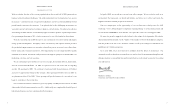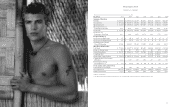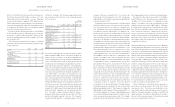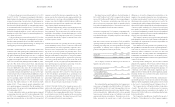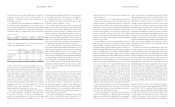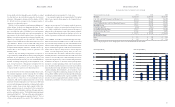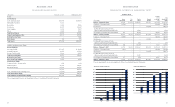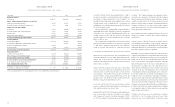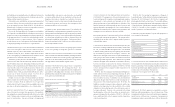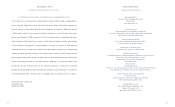Abercrombie & Fitch 2001 Annual Report Download - page 9
Download and view the complete annual report
Please find page 9 of the 2001 Abercrombie & Fitch annual report below. You can navigate through the pages in the report by either clicking on the pages listed below, or by using the keyword search tool below to find specific information within the annual report.
1716
Ab e r cr omb i e&Fitch Ab e rcrombi e &Fitch
have the right to draw upon the standby letters of credit if the
Company has authorized or filed a voluntary petition in
bankruptcy. To date, the beneficiaries have not drawn upon the
standby letters of credit.
As of Fe b ru a ry 2, 2002, the Company was committed to non-
cancelable leases with remaining terms of one to fourteen years.
These commitments include store leases with initial terms ranging
primarily from ten to fifteen years. A summary of minimum rent
commitments under noncancelable leases follows (thousands):
Payments Due by Period
Total Less than 1 Ye a r 1-3 Years 4-5 Years After 5 Years
$822,920 $104,085 $211,270 $198,459 $309,106
STORES AND GROSS SQ U ARE FEET Store count and gross
square footage by division were as follows:
February 2, 2002 February 3, 2001
Number Gross Square Number Gross Square
of Stores Feet (thousands) of Stores Feet (thousands)
Abercrombie & Fitch 309 2,798 265 2,443
abercrombie 148 662 84 375
Hollister Co. 34 213 5 31
Total 491 3,673 354 2,849
C A P I TAL EXPENDITURES Capital expenditures, net of con-
s t ruction allowances, totaled $126.5 million, $153.5 million and
$73.4 million for 2001, 2000 and 1999, respectively. Ad d i t i o n a l l y,
the noncash accrual for construction in progress totaled $1.0
million, $9.5 million and $10.4 million in 2001, 2000 and 1999,
r e s p e c t i v e l y. Capital expenditures related to the construction of
a new office and distribution center, including the noncash
a c c r ual for construction in progress, accounted for approxi-
mately $17 million, $92 million and $27 million of total capital
expenditures in 2001, 2000 and 1999, respectively. The office and
distribution center were completed in 2001. The balance of
capital expenditures related primarily to new stores.
The Company anticipates spending $105 to $115 million in
2002 for capital expenditures, of which $85 to $95 million will be
for new stores construction. The balance of expenditures pri-
marily relates to improving the in-store information technology
s t ructure and improvements in the distribution center. The
Company intends to add approximately 815,000 gross square feet
in 2002, which will represent a 22% increase over year-end 2001.
It is anticipated the increase will result from the addition of
approximately 40 new Abercrombie & Fitch stores, 30 aber-
crombie stores and 60 Hollister Co. stores.
The Company estimates that the average cost for leasehold
improvements and furniture and fixtures for Abercrombie & Fi t c h
stores opened in 2002 will approximate $600,000 per store, aft e r
giving effect to landlord allowances. In addition, inventory pur-
chases are expected to average approximately $300,000 per store.
The Company estimates that the average cost for leasehold
improvements and furniture and fixtures for abercrombie stores
opened in 2002 will approximate $500,000 per store, after giving
effect to landlord allowances. In addition, inventory purchases
are expected to average approximately $150,000 per store.
The Company estimates that the average cost for leasehold
improvements and furniture and fixtures for Hollister Co. stores
opened in 2002 will approximate $750,000 per store, after giving
effect to landlord allowances. However, the Company is in the
early stages of developing Hollister Co. and, as a result, current
average costs for leasehold improvements and furniture and fixtures
are not representative of future costs. In addition, inventory pur-
chases are expected to average approximately $250,000 per store.
The Company expects that substantially all future capital
expenditures will be funded with cash from operations. In addi-
tion, the Company has available a $150 million credit agreement
to support operations.
CRITICAL ACCOUNTING POLICIES AND ESTIMATES T h e
C o m p a n y’s discussion and analysis of its financial condition
and results of operations are based upon the Company’s con-
solidated financial statements, which have been prepared in
accordance with accounting principles generally accepted in
the United States of America. The preparation of these finan-
cial statements requires the Company to make estimates and
assumptions that affect the reported amounts of assets, liabilities,
revenues and expenses. Since actual results may differ from those
estimates, the Company revises its estimates and assumptions as
new information becomes available.
The Company’s significant accounting policies can be found
in the Notes to Consolidated Financial Statements (Note 2).
The Company believes that the following policies are most
critical to the portrayal of the Company’s financial condition and
results of operations.
Revenue Recognition - The Company recognizes retail sales at
the time the customer takes possession of the merchandise and
purchases are paid for, primarily with either cash or credit card.
Catalogue and e-commerce sales are recorded upon shipment of
merchandise. Amounts relating to shipping and handling billed
to customers in a sale transaction are classified as revenue and the
related costs are classified as cost of goods sold. Employee dis-
counts are classified as a reduction of revenue. The Company
reserves for sales returns through estimates based on historical
experience and various other assumptions that management
believes to be reasonable.
I n v e n t o ry Valuation - Inventories are principally valued at the
lower of average cost or market, on a first-in first-out basis, utilizing
the retail method. The retail method of inventory valuation is an
averaging technique applied to different categories of inventory. At
A & F, the averaging is determined at the stock keeping unit (SKU )
level by averaging all costs for each SKU. An initial markup is
applied to inventory at cost in order to establish a cost-to-retail ratio.
Permanent markdowns, when taken, reduce both the retail and cost
components of inventory on hand so as to maintain the already
established cost–to-retail relationship. The use of the retail method
and the taking of markdowns effectively values inventory at the
lower of cost or market. The Company further reduces inventory
by recording an additional markdown reserve using the retail
c a r rying value of inventory from the season just passed.
Markdowns on this carryover inventory represent the future
anticipated selling prices. Ad d i t i o n a l l y, as part of inventory val-
uation, an inventory shrinkage estimate is made each period
that reduces the value of inventory for lost or stolen items.
Inherent in the retail method calculation are certain significant
judgments and estimates including, among others, initial markup,
markdowns and shrinkage, which could significantly impact
the ending inventory valuation at cost as well as resulting gross
margins. Management believes that this inventory valuation
method provides a conservative inventory valuation as it preserv e s
the cost-to-retail relationship in inventory.
Property and Equipment - Depreciation and amortization of
property and equipment are computed for financial reporting
purposes on a straight-line basis, using service lives ranging prin-
cipally from 10-15 years for leasehold improvements and 3-10
years for other property and equipment. Beneficial leaseholds
represent the present value of the excess of fair market rent over
contractual rent of existing stores at the 1988 purchase of the
Abercrombie & Fitch business by T he Limited, Inc. (“The
Limited”) and are being amortized over the lives of the related
leases. The cost of assets sold or retired and the related accumu-
lated depreciation or amortization are removed from the accounts
with any resulting gain or loss included in net income.
Maintenance and repairs are charged to expense as incurred.
Major renewals and betterments that extend service lives are cap-
italized. Long-lived assets are reviewed at the store level at least
annually for impairment or whenever events or changes in cir-
cumstances indicate that full recoverability is questionable. Fa c t o r s
used in the evaluation include, but are not limited to, manage-
ment's plans for future operations, recent operating results and
projected cash flows.
Income Taxes - Income taxes are calculated in accordance with
Statement of Financial Accounting Standards (“SFAS”) No.
109, “Accounting for Income Taxes,” which requires the use of the
liability method. Deferred tax assets and liabilities are recognized
based on the difference between the financial statement carry i n g
amounts of existing assets and liabilities and their respective tax
bases. Inherent in the measurement of deferred balances are cer-
tain judgments and interpretations of enacted tax law and
published guidance with respect to applicability to the Company’ s
operations. Significant examples of this concept include capital-
ization policies for various tangible and intangible costs, income
and expense recognition and inventory valuation methods. No
valuation allowance has been provided for deferred tax assets
because management believes the full amount of the net deferred
tax assets will be realized in the future. The effective tax rate uti-
lized by the Company reflects management’s judgment of the
expected tax liabilities within the various taxing jurisdictions.
R E C E N T LY ISSUED ACCOUNTING PRONOUNCEMENTS
In June 2001, the Financial Accounting Standards Board (“FA S B” )
issued SFAS No. 142, “Goodwill and Other Intangible Assets.”
The standard is effective starting with fiscal years beginning aft e r
December 15, 2001 (Fe b ru a ry 3, 2002 for the Company). SFA S
No. 142 addresses how intangible assets that are acquired indi-
vidually or with a group of other assets should be accounted for
in financial statements upon their acquisition. It also addresses




